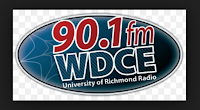When
folks think of Richmond, Virginia, the first word that comes to mind is often
“historic.”
From early settlements before the Revolutionary War, to being the
capital of the Confederacy, to the Civil Rights movement, Richmond has been the
heart of the action.
Richmond
today it is fast-growing metropolitan area with ample job opportunities with
the Virginia State Government, Capitol One Financial, VCU Health System, DuPont
and Dominion Energy Resources.
Despite
the progress, Richmond’s urban core and affluent suburbs are two different
worlds. According to local sources, the number one local issue is “urban
sprawl.”
 |
| Bill Miller |
Commonwealth
Broadcasting [link] is the largest public media shop in Richmond. Commonwealth
owns and operates PBS station WCVE-TV, three radio stations, data services and
educational outreach. Bill Miller, VP and GM of WCVE Radio kindly offers his
comments about Richmond and WCVE:
Miller: While
I think many radio users in town would bemoan the lack of or decline in
interesting or diverse commercial radio formats, Richmond has proved itself to
be a hospitable environment for noncommercial radio.
As is the
case elsewhere, there has been a lot of consolidation in Richmond’s commercial
media. The city used to have two, independent, daily newspapers; now we now
have one: The Richmond Times-Dispatch. Four commercial television stations have
nightly newscasts. Commercial radio outlets are dominated by two consolidated
companies: Entercom and Radio One.
WCVE’S EXPANDING ROLE IN
RICHMOND
Miller: For a
couple of decades, our listeners have told us that they want more programming
choices than what we have offered on WCVE. Classical and Jazz music were often
mentioned by people want additional channels. Plus, there has been considerable
demand for 24/7 public radio news and information.
For years
we kept searching for available signals for additional programming but none
were available until Fall 2017. Then we were able to purchase two commercial
frequencies at 93.1 FM and 107.3 FM and convert them to noncommercial public
radio. Soon these two frequencies will airing Classical music, plus Jazz for 25-hours-a-week.
We are simulcasting programming now but in the Spring we will have two program
streams.
MILLER: Our plan is
to significantly grow our local content on both services, with more hours of
locally programmed music, more hours of live interview and performance from our
studios, more and better reporting on local stories for insert into the NPR
newsmagazines, and new WCVE-produced interview and forum programming.
On the new
93.1 and 107.3, local classical music hosts Shawn Evans and Mike
Goldberg will continue to broadcast classical music during the day. Our Jazz
host, Peter Solomon, will have music during the evenings.
RICHMOND IS BECOMING AN “ESSENTIAL
PUBLIC RADIO” MARKET
“Essential
public radio” means, in part, all of the major public radio formats are
available over-the-air to listeners. With the addition of Classical and Jazz on
WCVE’s new sister station, Richmond stations will offer listeners more
noncommercial choices. Here are the other players:
 |
| Recent WNRN pledge drive |
• Triple A WNRN [link], is upgrading its
signal to provide better coverage in Richmond. Miller is a fan of WNRN and he knows
of their popularity:
MILLER: WNRN
originates in Charlottesville but brings a unique AAA format to Richmond and
towns throughout central and western Virginia. It has a loyal following here.
• NFCB-ish WRIR [link] has been serving
Richmond for over a decade with a variety of volunteer music shows, political
talk such as Democracy Now! plus
weekly public radio programs not heard elsewhere in the market.
MILLER: WRIR
is accomplished at celebrating local rock and new music performers, hosting
community events, and providing hyper-local attention to community issues.
• WDCE [link] is one of the best college stations in the nation. Licensed to the University of Richmond, WDCE is an integral part of Richmond’s Indie community.
MILLER: WDCE opens the airwaves to the
widest range of music, from Baroque to Hip Hop, and to the most diverse group
of people - students, alums, and community contributors.
OTHER NOTABLE NONCOM
STATIONS IN RICHMOND
• WNVU (89.7 FM) is one of the first stations outside of California to air Educational Media Foundation’s new Spanish-language Christian music format Radio Nueva Vida (“New Life”).
• KAWZ’s ("Christian Satellite Network) translator at 91.7 FM demonstrates why the FCC should consider ending the policy that allows noncommercial stations to operate in distant locations and no tie to the local community.
 |
| CSN HQ in Twin Falls, 2,518 miles from Richmond |

































